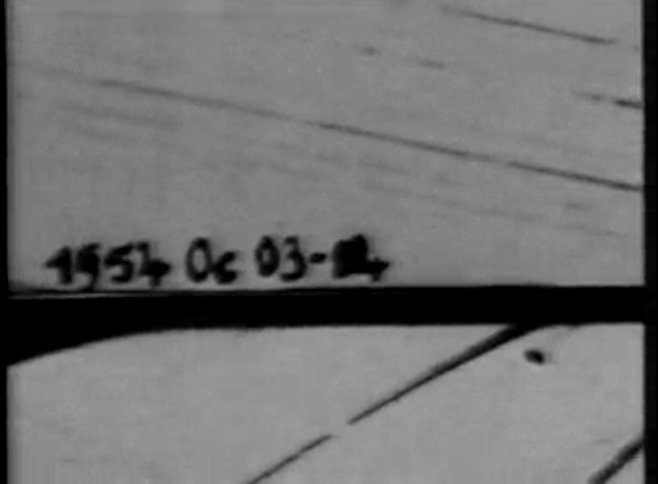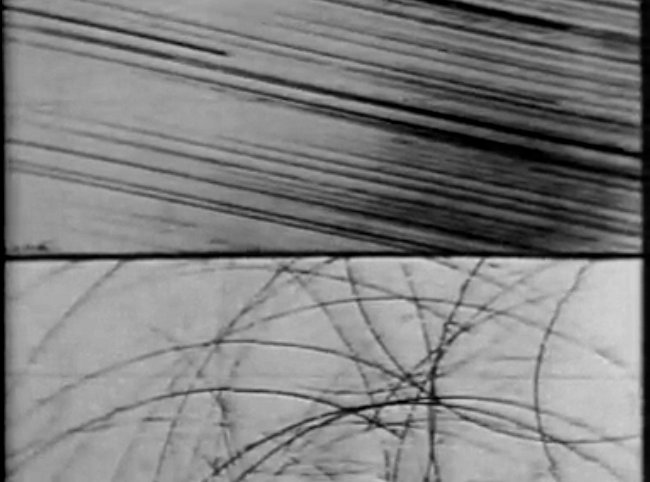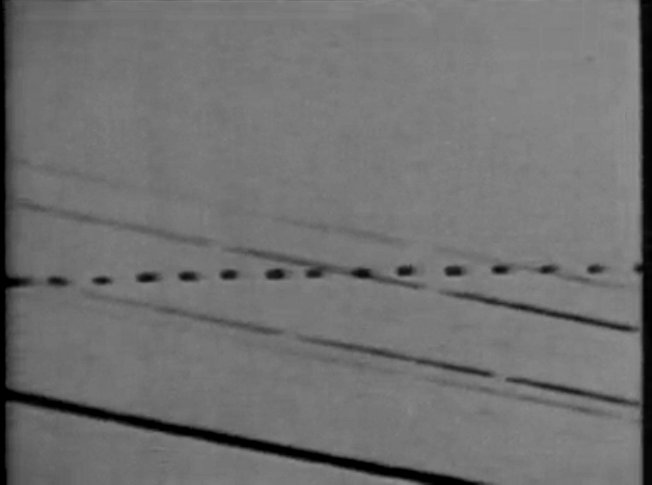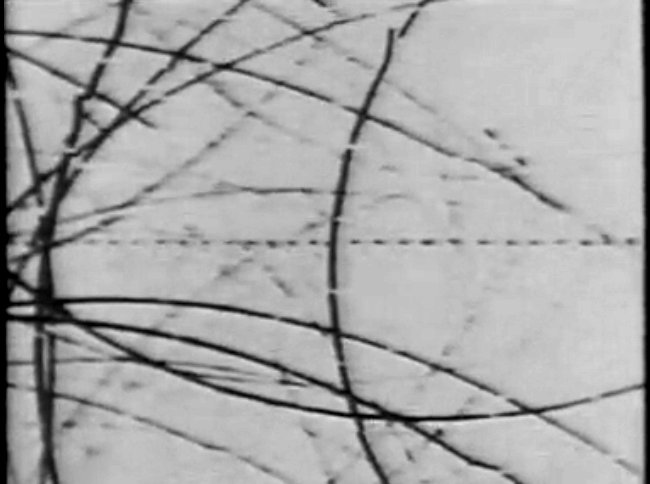
The index page for the 1954 French flap section of this site is here.
Reference for this case: 3-Oct-54-sky.
Please cite this reference in any correspondence with me regarding this case.
During an ORTF (French national television of the time) broadcast on flying saucers aired on February 14, 1965, we see pioneering ufologist Aimé Michel presenting an astrophotography taken on October 3, 1954, by the used of a trajectory analyzer.
Aimé Michel explains what we see, which would be an object which had passed in a straight line over the portion of sky covered by the device, an "unidentified object", according to the astronomer who detected it, said Michel.
[Ref. aml1:] AIME MICHEL:
On February 14, 1965, the ORTF broadcast a report entitled "The flying saucers", including the French ufologist Aimé Michel. The report was not "pure saucerian propaganda", both "proponent" opinions and "skeptical" opinions were voiced.
During the report, Aimé Michel showed two cases of astronomical photographs taken with a trajectory analyzer. He explained that the trajectory analyzer takes two photos, that of the top taken in "fixed chamber", that of the bottom taken in "rotating chanber". Michel shows two of them, and explains what they are, one of a plane in the sky, the other of a meteor in the sky.
He explained that the dotted line in the trajectory of these objects does not come from the plane and meteor phenomena themselves, but from the fact that the chamber is closed every 10th of a second (which allows to calculate the angular speed of moving objects).
Aimé Michel then shows a double photograph from the same source, that an astronomer took on October 3, 1954, described by the astronomer as a "suspicious object."
Michel said:
"But here's something more curious."
"This is a double photo which was taken precisely in... uh... 1954, [the camera zoomed in on the part of the image giving the precise date of October 3, 1954] during this great flap, and this object qualified by the astronomer who took the photo of "suspicious object", you know, unidentified."
"In this double photo, we see in the fixed chamber and in the rotating chamber, we see a series of dots moving at a relatively restricted speed and in, in a rigorously rectilinear manner, and the object appears at one end of the photo and disappears at the other end of the photo, it therefore continued beyond the limit of, of the photo, and consequently it moved on a fairly large arc of circle in the sky."
"Well, this one is quite inexplicable because it seems to move faster than an airplane, slower than a meteorite and in a straight line, it is a suspicious object, an object which consequently calls for attention and calls for investigation."
While Aimé Michel is speaking, the TV camera shows images of said astrophotography. First a zoom in the corner of the said photo, clearly showing the date of October 3, 1954, and perhaps the time, but the part thay may show the time is illegible. There is no indication of place or origin.

|
We then have a wide view, but the suspicious object cannot be distinguished there (the very low definition of TV recordings at the time explains this easily):

|
We can clearly see on the images the traces of the stars, straight or cycloid depending on whether they come from the rotating chamber or the fixed chamber.
The camera pans the photo; you do see that the dotted path actually goes from one end of the photo to the other in straight line.

|
A part of the lowe part of the double photo is shown:

|
"Suspicious object" is indeed the term that astronomers used in the bulletin of the Société Astronomique de France, where neither "UFO" nor "flying saucer" was written. The object cannot in principle be an artificial satellite sent from Earth, there had been none before "Sputnik 1" on October 4, 1957.
Unfortunately, I am not "qualified" to analyze images from a 1954 trajectory analyzer.
I can nevertheless regret that a document of scientific nature, which should interest scientists, ended with the somewhat sad fate that the TV broadcast held for it. Indeed, it would have been sensible to give the quantitative indications relating to this detection, such as the portion of sky covered, the exact speed of movement (we are told, faster than an airplane, slower than a "meteorite" (a meteor, the meteorite being a remnant of meteor fallen to the ground). If I had the speed of movement of the film and the original of the recording, I could have calculated this apparent speed, but these data were not given. I am not even able to say whether that could have been a planet or not, I have to stick to the astronomer's opinion given by Aimé Michel.
I can therefore just conclude that reasonably, this seems to be a case of detection of an unidentified object in the sky, unidentified for the astronomer who took it according to Aimé Michel. An interesting, but poorly documented case. What a pity!
(These keywords are only to help queries and are not implying anything.)
Sky, astronomer, photo, astrophotography, unidentified, trajectory analyser
[----] indicates sources that are not yet available to me.
| Version: | Created/Changed by: | Date: | Change Description: |
|---|---|---|---|
| 1.0 | Patrick Gross | January 24, 2020 | First published. |